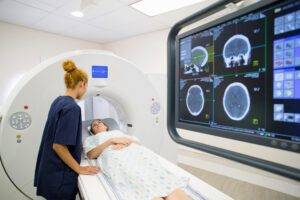Healthcare software development is a complex and multifaceted process. A development team needs to integrate advanced technologies and ensure that there are no flaws in the security aspect all while meeting stringent regulatory requirements.
But what lies at the heart of basically any healthcare software? What systems form the core of modern healthcare software and why does unfolding full customization potential for individual healthcare providers come with a decent number of challenges?
Let’s get the answers to all these questions!
Without These Core Systems, Your Software Won’t Work
Most healthcare custom software development projects begin with the Electronic Health Records system or EHR.
Your healthcare software can’t work without an EHR system. It’s responsible for storing, retrieving, and managing patient records digitally. It also ensures that patients’ information is accessible to authorized personnel in real-time, which gives better coordination of care.
Here are some examples of what the Electronic Health Records system works with:
Patient history and demographics
Medication and allergy lists
Lab test results
Radiology images
Billing images
Billing information
Practice Management Systems
A PMS is another cornerstone of healthcare. This system helps healthcare providers manage the day-to-day operations of their practice, be it appointment scheduling, billing, or administrative tasks.
Clinical Decision Support Systems
Today, CDSS uses artificial intelligence to assist you in making informed clinical decisions. The core function of a CDSS is to analyze patient data and provide recommendations based on clinical guidelines and evidence-based practices. A CDSS in your healthcare software also works as an alert system for potential issues, like drug interaction issues.
What Has Room for Customization?
Before continuing with core and pretty much unchangeable elements of healthcare software, it’s worth mentioning that customization is critical in this industry. Only with the customization you can meet your unique needs as a healthcare provider.
Going from the smallest to the biggest elements you’re free to shape, we have a user interface. When it comes to UI, you usually have plenty of room for tailoring the look and feel of your system to match your workflow and preferences.
Then, reporting tools. Some data must be presented in your reports at all times, but all in all, they can be developed to meet your specific analytical needs.
You can also have custom solutions in terms of integration with existing systems. That can be laboratory information systems (LIS) or pharmacy management systems for seamless data exchange.
Important! Specific security protocols and regulatory standards will vary based on the information you’re gathering, the country (or countries!) you operate in, as well as other categories you may be referred to.
In Healthcare Software, There Is a Standard or Protocol for Everything
Data standards together with interoperability modules and other protocols are what make your healthcare app consistent and accurate.
ICD-10 and SNOMED are two key standards used worldwide.
ICD-10, or International Classification of Diseases, 10th revision, is often described as a coding system. It categorizes diseases, symptoms, and procedures to make sure the documentation and reporting are precise. It is something that keeps all those detailed patient records, health statistics, billing, and clinical research accurate.
SNOMED CT is a clinical terminology system. It covers diseases, procedures, findings, and medications. It is also used for detailed and precise coding of clinical information and ensures interoperability between different healthcare systems.
HIPAA and GDPR Compliance Modules
Compliance modules are modules that ensure adherence to stringent regulations. These modules incorporate various features that maintain data privacy, security, and integrity.
For HIPAA-compliant app development, your software must:
Encrypt data at rest and in transit
Implement role-based access controls
Maintain detailed logs of all data access
Anonymize patient data for research and analytics
To comply with the GDPR means to:
Track and manage patients’ consent for data processing activities
Give patients mechanisms to request the deletion of their personal data
Facilitate the secure transfer of personal data to other systems
Include automated systems to detect, respond to, and report data breaches within the mandated time frames
Protocols for Interoperability
For interoperability, we have standardized protocols like HL7 and FHIR. Both of them guarantee that healthcare data is shared and understood across different platforms, but each protocol has its own unique distinctions.
Health Level Seven (HL7) defines a framework for the exchange, integration, sharing, and retrieval of electronic health information. It supports a wide range of healthcare workflows through its messaging standards. As for today, HL7 has version 3 as the most rigorous framework. Version 3 includes a Reference Information Model, or RIM, for more complex data representations and interactions.
Fast Healthcare Interoperability Resources (FHIR) goes with a set of “resources”, best to say data structures, that represent granular clinical concepts, such as patients, encounters, and observations.
FHIR works web-based protocols, such as RESTful APIs, perfectly. It means that the integration of web applications, mobile apps, and cloud services, is seamless. FHIR resources can be exchanged in both JSON and XML formats, which adds flexibility and compatibility with various systems.
What Makes the Development So Complicated?
The more customized your healthcare software solution is, the more difficult it is to develop it. Custom solutions must still be integrated with various existing systems, they must meet all relevant regulatory requirements all while protecting every bit of information from breaches and cyberattacks.
Yes, developing such software in-house is daunting. That’s mostly the reason why many healthcare providers find it beneficial to partner with a healthcare custom software development team. Their expertise eases the development and gives you an effective and ready-to-use solution in the end.
The catch is that custom solutions in healthcare software have the biggest chance of being successful. Only custom solutions address unique workflows and provide specialized functionality that off-the-shelf software cannot.
Conclusion
Modern healthcare software is as much useful as it is complex. But it’s all those systems combined that give us highly functional pieces of software that improve patients’ lives and make it easy for doctors to provide care.
Read more:
What Are the Core Elements of Any Healthcare Software We Have Today?















